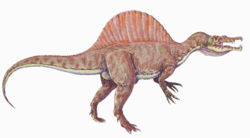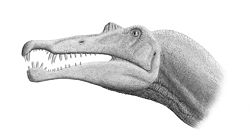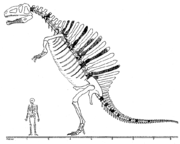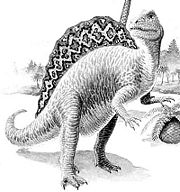Spinosaurus
2008/9 Schools Wikipedia Selection. Related subjects: Dinosaurs
| Spinosaurus Fossil range: mid Cretaceous |
||||||||||||||||||
|---|---|---|---|---|---|---|---|---|---|---|---|---|---|---|---|---|---|---|
 |
||||||||||||||||||
| Scientific classification | ||||||||||||||||||
|
||||||||||||||||||
| Species | ||||||||||||||||||
|
Spinosaurus (meaning "spine lizard") is a genus of theropod dinosaur which lived in what is now North Africa, from the Albian to early Cenomanian stages of the Cretaceous Period, about 100 to 93 million years ago. This genus was first known from Egyptian remains discovered in the 1910s and described by German paleontologist Ernst Stromer. These original remains were destroyed in World War II, but additional skull material has come to light in recent years. It is unclear whether one or two species are represented in the described fossils. The best known species is S. aegyptiacus from Egypt, although a potential second species, S. marocannus, has been recovered from Morocco.
The distinctive "spines" of Spinosaurus, which were long extensions of the vertebrae, grew up to 2 metres (6.6 ft) long and were likely to have had skin connecting them, forming a sail-like structure, although some authors have suggested that they were covered in muscle and formed a hump or ridge. Multiple functions have been put forward for this structure, including thermoregulation and display. According to recent estimates, Spinosaurus is the largest of all known carnivorous dinosaurs, even larger than Tyrannosaurus rex and Giganotosaurus. These estimates suggest that it was around 16 to 18 meters in length (52.5 to 59.1 ft) and 7 to 9 tonnes (7.7 to 9.9 tons) in weight.
Description
Although Spinosaurus is well-known to dinosaur enthusiasts due to its size, sail, and elongated skull, it is mostly known from remains that have been destroyed, aside from a few more recently discovered teeth and skull elements. Additionally, so far only the skull and backbone have been described in detail, and limb bones have not been found. Jaw and skull material published in 2005 show that it had one of the longest skulls of any carnivorous dinosaur, estimated at about 1.75 meters long (5.75 ft). The skull had a narrow snout filled with straight conical teeth that lacked serrations. There were six or seven teeth on each side of the very front of the upper jaw, in the premaxilla bones, and another twelve in both maxillae behind them. The second and third teeth on each side were noticeably larger than the rest of the teeth in the premaxilla, creating a space between them and the large teeth in the anterior maxilla; large teeth in the lower jaw faced this space. The very tip of the snout holding those few large anterior teeth was expanded, and a small crest was present in front of the eyes.
The sail of Spinosaurus was formed of very tall neural spines growing on the back vertebrae. These spines were seven to eleven times the height of the vertebrae from which they grew. The spines were slightly longer front to back at the base than higher up, and were unlike the thin rods seen in the pelycosaur finbacks Edaphosaurus and Dimetrodon.
Classification
|
A cladogram of the Spinosauridae showing the position of Spinosaurus
|
Spinosaurus gives its name to a family of dinosaurs, the Spinosauridae, of which other members include Baryonyx from southern England, Irritator and Angaturama (which is probably synonymous with Irritator) from Brazil, Suchomimus from Niger in central Africa, and possibly Siamosaurus, which is known from fragmentary remains in Thailand. Spinosaurus is closest to Irritator, which shares its unserrated straight teeth, and the two are included in the subfamily Spinosaurinae. In 2003, Oliver Rauhut suggested that Stromer's Spinosaurus holotype was a chimera, composed of back vertebrae from a carcharodontosaurid similar to Acrocanthosaurus and a dentary from a large theropod similar to Baryonyx. This analysis, however, has been rejected in recent papers.
Discovery and species
The first described remains of Spinosaurus were found in the Bahariya Valley of Egypt in 1912, and were named by German paleontologist Ernst Stromer in 1915. Fragmentary additional remains from Bahariya, including vertebrae and hindlimb bones, were designated by Stromer as "Spinosaurus B" in 1934. Stromer considered them different enough to belong to another species, and this has been borne out; with the advantage of more expeditions and material, it appears that they either pertain to Carcharodontosaurus or to Sigilmassasaurus. Some of the Spinosaurus fossils were damaged during transport back to the Deutsches Museum, in Munich, Germany, and the remaining bones were completely lost due to Allied bombing in 1944.
Two species of Spinosaurus have been named: Spinosaurus aegyptiacus (meaning "Egyptian spine lizard") and Spinosaurus marocannus (meaning "Moroccan spine lizard"). S. marocannus was originally described by Dale Russell as a new species based on the length of its neck vertebrae. Later authors have been split on this topic, some considering the length of the vertebrae to be variable from individual to individual and therefore regarding S. marocannus as invalid or a synonym of S. aegyptiacus, and others retaining it as valid.
Specimens
Six partial specimens of Spinosaurus have been described. The probable size of these individual spinosaurs can be estimated using comparison to known material from other spinosaurid dinosaurs. The estimates below are based on the Theropod Database and Dal Sasso et al, 2005.
IPHG 1912 VIII 19, described by Stromer in 1915, was the holotype. This specimen, from a subadult individual, was destroyed in World War II. However, detailed drawings and descriptions of the specimen remain. The individual is estimated to have been around 14 meters (46 ft) long and to have weighed about 6.7 tonnes (7.4 tons). The material consisted of a maxilla (upper jaw) fragment, an incomplete dentary (lower jaw) measuring 750 millimeters (29.5 in) long, (the skull is estimated to have been 1.45 meters (4.76 ft) long with a mandible approximately 1.34 meters (4.40 ft) long), nineteen teeth, two incomplete cervical vertebrae, seven back vertebrae, dorsal ribs, gastralia, and eight caudal centra. This was the specimen that Rauhut thought was chimeric.
CMN 50791, described by Russell in 1996, is the holotype of Spinosaurus marocannus. The material it is based on includes a mid-cervical vertebra which is 195 millimeters (7.68 in) long, an anterior dorsal neural arch, an anterior dentary, and a mid-dentary. MNHN SAM 124, described by Taquet and Russell in 1998, consists of partial premaxillae, partial maxillae, vomers, and a dentary fragment. They came from an individual estimated to have been about 14 meters (46 ft) long and to have weighed about 6.7 tonnes (7.38 tons). The skull is estimated at approximately 1.42 meters (4.66 ft) long. Office National des Mines nBM231, described by Buffetaut and Ouaja in 2002, consists of an anterior dentary from Tunisia which is very similar to existing material of S. aegyptiacus.
MSNM V4047, described by Cristiano Dal Sasso of the Civic Natural History Museum in Milan and his colleagues in 2005, consists of premaxillae, partial maxillae, and partial nasals, which together measure 988 millimeters (3.24 ft) long. The massive skull is estimated at 1.75 meters (5.74 ft) long, and the entire animal is estimated to have been around 16 to 18 meters (52 to 59 ft) in length and weighed around 7 to 9 tonnes (7.7 to 9.9 tons). UCPC-2, also described by Dal Sasso et al. in 2005, consists of a 'fluted crest' from the region in front of the eyes.
Paleoecology
The environment inhabited by Spinosaurus is only partially understood, and covers a great deal of what is now northern Africa. Those Spinosaurus that lived in what is now Egypt, for example, may have contended with shoreline conditions on tidal flats and channels, living in mangrove forests alongside similarly large dinosaurian predators Bahariasaurus and Carcharodontosaurus, giant titanosaur sauropod Paralititan, smaller titanosaur Aegyptosaurus, 10 meter (33 ft) long crocodilian Stomatosuchus, and the coelacanth Mawsonia.
Feeding ecology
It is unclear whether Spinosaurus was primarily a terrestrial predator or a fisher, as indicated by its elongated jaws, conical teeth and raised nostrils. The only direct evidence for spinosaur diet comes from related European and South American taxa. Baryonyx was found with both fish scales and bones from juvenile Iguanodon in its stomach, while a tooth embedded in a South American pterosaur bone suggests that spinosaurs occasionally preyed on these flying archosaurs. Spinosaurus was likely to have been a generalized and opportunistic predator, possibly a Cretaceous equivalent of large grizzly bears, being biased toward fishing, though it undoubtedly scavenged and took many kinds of small or medium-sized prey.
Paleobiology
Size
Since its discovery, Spinosaurus has been a top contender for longest and largest theropod dinosaur, though this fact did not reach the public consciousness until its depiction in the film Jurassic Park III and the description of a new specimen in 2005. Both Friedrich von Huene and Donald F. Glut, decades apart, listed it as among the most massive theropods or the most massive in their surveys, at upwards of 6 tons in weight and 15 meters (50 feet) in length. In 1988, Gregory S. Paul also listed it as the longest theropod at 15 meters (50 feet), but gave a lower mass estimate. More recent estimates, based on new specimens, list Spinosaurus at 16 to 18 metres (53.3 to 60 feet) long and 7 to 9 tonnes in weight (7.7 to 9.9 tons).
François Therrien and Donald Henderson, in a 2007 paper using scaling based on skull length, challenged previous estimates, finding the length too great and the weight too small. Their estimates include a length of 12.6 to 14.3 meters (41.3 to 47.0 ft) and a mass of 12.0 to 20.9 tonnes (13.2 to 23.0 tons). Their study has been criticized for the choice of large theropods used for comparison (most of the skeletons of large theropods used to set the initial equations are of tyrannosaurids and carnosaurs, which have a different build than spinosaurids) and for issues relating to their spinosaurid skull reconstructions. Resolution awaits more complete remains.
Sail
Spinosaurus sails were unusual, although other dinosaurs of the same time and area, namely the ornithopod Ouranosaurus and the sauropod Rebbachisaurus, might have developed a similar structural adaptation of their dorsal vertebrae (however, this is not uncontroversial; see the articles about these animals for more information). The sail is possibly analogous (not homologous) to that of the Permian mammal-like reptile, Dimetrodon, which lived before the dinosaurs even appeared; these similarities are due to parallel evolution. The sail may also have been more hump-like than sail-like; as noted by Jack Bowman Bailey most recently, spinosaur spines are not thin rods but broad front to back, rather like those of some types of buffalo, and so may have supported a thicker, fatty structure as opposed to a skin sail.
The function of these sails is uncertain; scientists have proposed several hypotheses including heat regulation and display. In addition, such a prominent feature on its back could also make it appear even larger than it was, intimidating other animals.
If the sail contained abundant blood vessels, the animal could have used the sail's large surface area to absorb heat. This would imply that the animal was only partly warm-blooded at best and lived in climates where nighttime temperatures were cool or low and the sky usually not cloudy. It is thought that Spinosaurus and Ouranosaurus both lived in or at the margins of an earlier version of the Sahara Desert, which could explain this. It is also possible that the sail was used to radiate excess heat from the body, rather than to collect it. Large animals, due to the relatively small ratio of surface area of their body compared to the overall volume ( Haldane's principle), face far greater problems of dissipating excess heat at higher temperatures than gaining it at lower. Sails of these dinosaurs added considerably to the skin area of the body, with minimum increase of volume. Furthermore, if the sail was turned away from the sun, or positioned at a 90 degree angle towards a cooling wind, the animal would quite effectively cool itself in the warm climate of Cretaceous Africa.
Elaborate body structures of many modern-day animals usually serve to attract members of the opposite sex during mating. It is quite possible that the sails of these dinosaurs were used for courtship, in a way similar to a peacock's tail. Stromer speculated that males and females may have differed in the size of the neural spine. If this was the case, the sails may have been brightly colored, but this is purely speculative.
Finally, it is quite possible that the sail combined these functions, acting normally as a heat regulator, becoming a courting aid during the mating season, being used to cool itself and, on occasions, turning into an intimidating device when an animal was feeling threatened.
Posture
Although traditionally depicted as a biped, it has been suggested since the early 1980s that Spinosaurus was at least an occasional quadruped. This has been bolstered by the discovery of Baryonyx, a relative with robust arms. Bailey (1997) was sympathetic to a possible quadrupedal posture, leading to new restorations of it as such. This hypothesis has fallen out of favour, at least as a typical gait, though spinosaurids may have crouched in a quadrupedal posture.
In popular culture
Spinosaurus has long been depicted in popular books about dinosaurs, although only recently has there been enough information about spinosaurids for an accurate depiction to be made. Traditionally, it has been restored as a generalized upright theropod, with a skull similar to that of other large theropods and a sail on its back, after an influential 1955 skeletal reconstruction by Lapparent and Lavocat.
Spinosaurus was featured as the main " antagonist" in the 2001 film Jurassic Park III. It was portrayed as larger and more powerful than Tyrannosaurus, in a scene depicting a battle between the two resurrected predators where Spinosaurus emerges victorious by snapping the tyrannosaur's neck. In reality, such a battle could never have taken place while the species were still extant, since Spinosaurus and Tyrannosaurus lived thousands of kilometres and millions of years apart. After appearing in Jurassic Park III, Spinosaurus was featured in a wide variety of merchandise related to the Jurassic Park films, including a number of video games such as Jurassic Park: Operation Genesis from Vivendi Universal.
Spinosaurus also made an appearance in Megamorphs 2: In the Time of Dinosaurs, part of the Animorphs book series by K. A. Applegate, where the characters Rachel and Tobias fought one while in Deinonychus morphs. Both Spinosaurus and Deinonychus were erroneously depicted as living during the Maastrichtian age. Though Applegate later discovered her error, it was too late to write the scene out; she added a note from Tobias at the end of the book, explaining that - within the context of the story - paleontologists are actually incorrect about these genera.
Spinosaurus was also featured in the television documentary The Lost Dinosaurs of Egypt, in which it was seen wading through the marshlands of Cretaceous Egypt.






